Photo

You're Smile is real when you're with your favourite people🤭🥰🤗... . . . #throw🔙 #awesomeday😇 #capturedbybestie #positivevibes (at Kolhapur City) https://www.instagram.com/p/CH5ibVqpPfcSj8T3Aga89MBqG8b5q5oCmMIUvk0/?igshid=10h6ieg5ureiw
20 notes
·
View notes
Text
Boo-tiful Ring Galaxies

A ghoulish secret lurks within each of these gorgeous galaxies. Their rings are dotted with stellar graveyards!

These objects are called ring galaxies, and scientists think most of them form in monster-sized crashes. Not just any galaxy collision will do the trick, though. To produce the treat of a ring, a smaller galaxy needs to ram through the center of a larger galaxy at just the perfect angle.

The collision causes ripples that disturb both galaxies. The gravitational shock causes dust, gas, and stars in the larger galaxy’s disk to rush outward. As this ring of material plows out from the galaxy’s center, gas clouds collide and trigger the birth of new stars.

In visible light, the blue areas in the galaxies’ rings show us where young, hot stars are growing up. Faint, pink regions around the ring mark stellar nurseries where even younger stars set hydrogen gas aglow.
The newborn stars come in a mix of sizes, from smaller ones like our Sun all the way up to huge stars with tens of times the Sun’s mass. And those massive stars live large!
While a star like our Sun will last many billions of years before running out of fuel, larger stars burn much brighter and faster. After just a few million years, the largest stars explode as supernovae. When massive stars die, they leave behind a stellar corpse, either a neutron star or black hole.
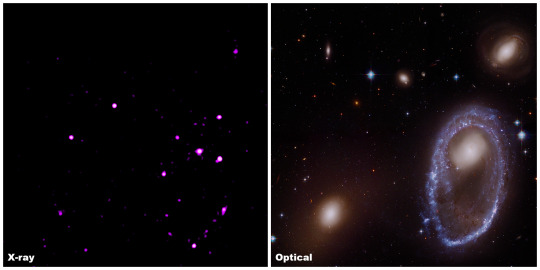
When we turn our X-ray telescopes to these ring galaxies, we see telltale signs of stellar remnants dotted throughout their ghostly circles. The purple dots in the X-ray image above are neutron stars or black holes that are siphoning off gas from a companion star, like a vampire. The gas reinvigorates stellar corpses, which heat up and emit X-rays. These gas-thirsty remains are beacons lighting the way to stellar graveyards.
Spiral galaxies — like our home galaxy, the Milky Way — have curved arms that appear to sweep out around a bright center. The dust and gas in those spiral arms press together, causing cycles of star formation that result in a more even mix of new stars and stellar corpses scattered throughout our galaxy. No creepy ring of stellar corpses here!
To visit some other eerie places in the universe, check out the latest additions to the Galaxy of Horrors poster series and follow NASA Universe on Twitter and Facebook for news about black holes, neutron stars, galaxies, and all the amazing objects outside our solar system.
Make sure to follow us on Tumblr for your regular dose of space: http://nasa.tumblr.com
4K notes
·
View notes
Text
The Lives, Times, and Deaths of Stars
Who among us doesn’t covertly read tabloid headlines when we pass them by? But if you’re really looking for a dramatic story, you might want to redirect your attention from Hollywood’s stars to the real thing. From birth to death, these burning spheres of gas experience some of the most extreme conditions our cosmos has to offer.

All stars are born in clouds of dust and gas like the Pillars of Creation in the Eagle Nebula pictured below. In these stellar nurseries, clumps of gas form, pulling in more and more mass as time passes. As they grow, these clumps start to spin and heat up. Once they get heavy and hot enough (like, 27 million degrees Fahrenheit or 15 million degrees Celsius), nuclear fusion starts in their cores. This process occurs when protons, the nuclei of hydrogen atoms, squish together to form helium nuclei. This releases a lot of energy, which heats the star and pushes against the force of its gravity. A star is born.
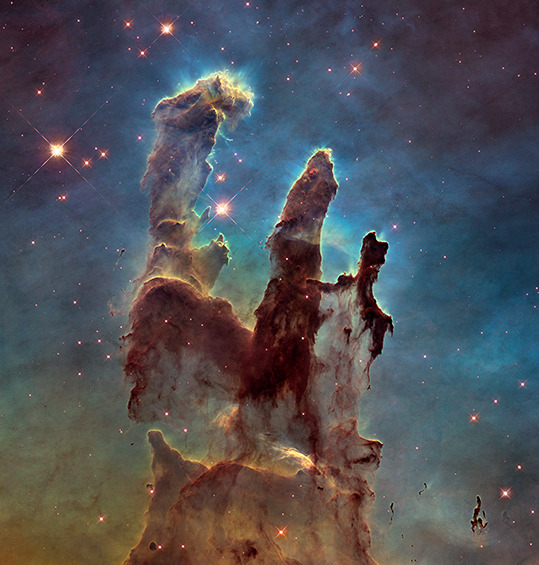
Credit: NASA, ESA and the Hubble Heritage Team (STScI/AURA)
From then on, stars’ life cycles depend on how much mass they have. Scientists typically divide them into two broad categories: low-mass and high-mass stars. (Technically, there’s an intermediate-mass category, but we’ll stick with these two to keep it straightforward!)
Low-mass stars

A low-mass star has a mass eight times the Sun’s or less and can burn steadily for billions of years. As it reaches the end of its life, its core runs out of hydrogen to convert into helium. Because the energy produced by fusion is the only force fighting gravity’s tendency to pull matter together, the core starts to collapse. But squeezing the core also increases its temperature and pressure, so much so that its helium starts to fuse into carbon, which also releases energy. The core rebounds a little, but the star’s atmosphere expands a lot, eventually turning into a red giant star and destroying any nearby planets. (Don’t worry, though, this is several billion years away for our Sun!)

Red giants become unstable and begin pulsating, periodically inflating and ejecting some of their atmospheres. Eventually, all of the star’s outer layers blow away, creating an expanding cloud of dust and gas misleadingly called a planetary nebula. (There are no planets involved.)

Credit: NASA, ESA, and the Hubble Heritage Team (STScI/AURA)
All that’s left of the star is its core, now called a white dwarf, a roughly Earth-sized stellar cinder that gradually cools over billions of years. If you could scoop up a teaspoon of its material, it would weigh more than a pickup truck. (Scientists recently found a potential planet closely orbiting a white dwarf. It somehow managed to survive the star’s chaotic, destructive history!)

High-mass stars
A high-mass star has a mass eight times the Sun’s or more and may only live for millions of years. (Rigel, a blue supergiant in the constellation Orion, pictured below, is 18 times the Sun’s mass.)
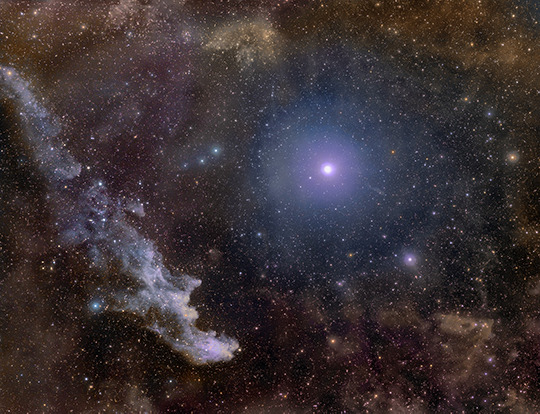
Credit: Rogelio Bernal Andreo
A high-mass star starts out doing the same things as a low-mass star, but it doesn’t stop at fusing helium into carbon. When the core runs out of helium, it shrinks, heats up, and starts converting its carbon into neon, which releases energy. Later, the core fuses the neon it produced into oxygen. Then, as the neon runs out, the core converts oxygen into silicon. Finally, this silicon fuses into iron. These processes produce energy that keeps the core from collapsing, but each new fuel buys it less and less time. By the point silicon fuses into iron, the star runs out of fuel in a matter of days. The next step would be fusing iron into some heavier element, but doing requires energy instead of releasing it.
The star’s iron core collapses until forces between the nuclei push the brakes, and then it rebounds back to its original size. This change creates a shock wave that travels through the star’s outer layers. The result is a huge explosion called a supernova.

What’s left behind depends on the star’s initial mass. Remember, a high-mass star is anything with a mass more than eight times the Sun’s — which is a huge range! A star on the lower end of this spectrum leaves behind a city-size, superdense neutron star. (Some of these weird objects can spin faster than blender blades and have powerful magnetic fields. A teaspoon of their material would weigh as much as a mountain.)
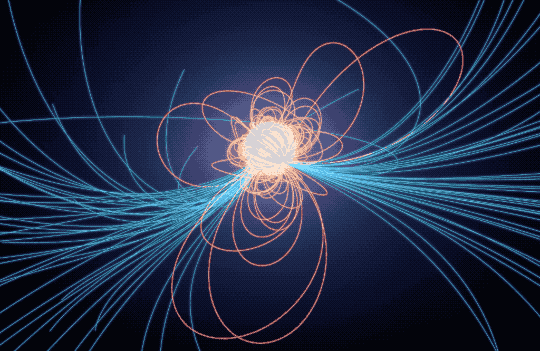
At even higher masses, the star’s core turns into a black hole, one of the most bizarre cosmic objects out there. Black holes have such strong gravity that light can’t escape them. If you tried to get a teaspoon of material to weigh, you wouldn’t get it back once it crossed the event horizon — unless it could travel faster than the speed of light, and we don’t know of anything that can! (We’re a long way from visiting a black hole, but if you ever find yourself near one, there are some important safety considerations you should keep in mind.)
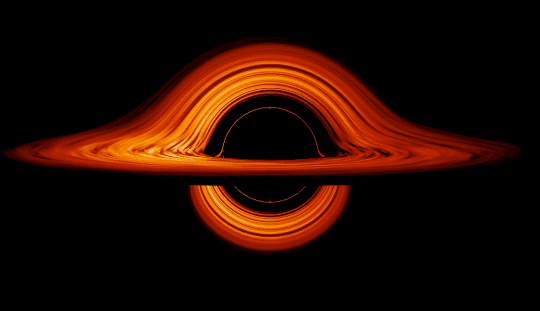
The explosion also leaves behind a cloud of debris called a supernova remnant. These and planetary nebulae from low-mass stars are the sources of many of the elements we find on Earth. Their dust and gas will one day become a part of other stars, starting the whole process over again.
That’s a very brief summary of the lives, times, and deaths of stars. (Remember, there’s that whole intermediate-mass category we glossed over!) To keep up with the most recent stellar news, follow NASA Universe on Twitter and Facebook.
Make sure to follow us on Tumblr for your regular dose of space: http://nasa.tumblr.com.
4K notes
·
View notes
Text
Tracking the Sun’s Cycles
Scientists just announced that our Sun is in a new cycle.
Solar activity has been relatively low over the past few years, and now that scientists have confirmed solar minimum was in December 2019, a new solar cycle is underway — meaning that we expect to see solar activity start to ramp up over the next several years.

The Sun goes through natural cycles, in which the star swings from relatively calm to stormy. At its most active — called solar maximum — the Sun is freckled with sunspots, and its magnetic poles reverse. At solar maximum, the Sun’s magnetic field, which drives solar activity, is taut and tangled. During solar minimum, sunspots are few and far between, and the Sun’s magnetic field is ordered and relaxed.

Understanding the Sun’s behavior is an important part of life in our solar system. The Sun’s violent outbursts can disturb the satellites and communications signals traveling around Earth, or one day, Artemis astronauts exploring distant worlds. Scientists study the solar cycle so we can better predict solar activity.

Measuring the solar cycle
Surveying sunspots is the most basic of ways we study how solar activity rises and falls over time, and it’s the basis of many efforts to track the solar cycle. Around the world, observers conduct daily sunspot censuses. They draw the Sun at the same time each day, using the same tools for consistency. Together, their observations make up the international sunspot number, a complex task run by the World Data Center for the Sunspot Index and Long-term Solar Observations, at the Royal Observatory of Belgium in Brussels, which tracks sunspots and pinpoints the highs and lows of the solar cycle. Some 80 stations around the world contribute their data.

Credit: USET data/image, Royal Observatory of Belgium, Brussels
Other indicators besides sunspots can signal when the Sun is reaching its low. In previous cycles, scientists have noticed the strength of the Sun’s magnetic field near the poles at solar minimum hints at the intensity of the next maximum. When the poles are weak, the next peak is weak, and vice versa.
Another signal comes from outside the solar system. Cosmic rays are high-energy particle fragments, the rubble from exploded stars in distant galaxies that shoot into our solar system with astounding energy. During solar maximum, the Sun’s strong magnetic field envelops our solar system in a magnetic cocoon that is difficult for cosmic rays to infiltrate. In off-peak years, the number of cosmic rays in the solar system climbs as more and more make it past the quiet Sun. By tracking cosmic rays both in space and on the ground, scientists have yet another measure of the Sun’s cycle.

Since 1989, an international panel of experts—sponsored by NASA and NOAA—meets each decade to make their prediction for the next solar cycle. The prediction includes the sunspot number, a measure of how strong a cycle will be, and the cycle’s expected start and peak. This new solar cycle is forecast to be about the same strength as the solar cycle that just ended — both fairly weak. The new solar cycle is expected to peak in July 2025.
Learn more about the Sun’s cycle and how it affects our solar system at nasa.gov/sunearth.
Make sure to follow us on Tumblr for your regular dose of space: http://nasa.tumblr.com.
2K notes
·
View notes
Photo

The Earth laughs in flowers 🤗😍🥰... . . . #flowers🌸 #pinkflowers🌺 #florals #nature #garden #homegardening🌱 https://www.instagram.com/p/CC5_3nMpP-rOD-qX4mcSLgFEswyx26RojL6ylg0/?igshid=gwz8zvangpai
2 notes
·
View notes
Photo

Escape the ordinary🤗🌼🌸... . . . #flowers🌸 #flowerpower🌸 #whiteflower🌼 #environmentalgraphics #environmentalmagic https://www.instagram.com/p/CBIE6kmJlUoqro9XO-UHXYRD6aJzGG-PoIPHsA0/?igshid=11zb4rxh2ca4
0 notes
Photo

The best things in life are usually found when you are not looking for them🤗🥰🥰... . . . #majorthrowback❤ #lifebeforequarantine #lifebeforelockdown #quarintined #quarintinelife #quarintine2020 #staypositiveinlife #stayhappy😊 (at Rankala Lake) https://www.instagram.com/p/CAz38jdJRFzp9jXbkOPhiwbJ7wR6RbFRJnCvjU0/?igshid=mpx4g5uqcew0
#majorthrowback❤#lifebeforequarantine#lifebeforelockdown#quarintined#quarintinelife#quarintine2020#staypositiveinlife#stayhappy😊
0 notes
Photo

A smile is a curve that sets everything straight... . . . #goodvibes #positivevibes #positivity #clickedbyhuman👧😜 #camera📷 #photography #blacklove #blackisthenewblack https://www.instagram.com/p/B-HZSR0JAyoGCj7qd04nwy6qoPlpNNl9EWDDWQ0/?igshid=gchflxtm9a69
#goodvibes#positivevibes#positivity#clickedbyhuman👧😜#camera📷#photography#blacklove#blackisthenewblack
0 notes
Photo

Stay open minded, things aren't always what they seem to be🤗☺️😊... . . . #quote #nightlights✨ #nightphotography #nightsky #sunsetorsunrise #sunset_vision #sunsetphotography #sunset_pic https://www.instagram.com/p/B9GHfX6p4GWT9bi0J2q2kQqSt3_DyblyFbq-n00/?igshid=hxmu3ylt5nt
#quote#nightlights✨#nightphotography#nightsky#sunsetorsunrise#sunset_vision#sunsetphotography#sunset_pic
1 note
·
View note
Photo

Find someone who brings out the best in you🤗🥰... . . (Pic Clicked by: @aditii_shete) #throw🔙 #mobileclicked #clickbybestie📷❣️ #awesome_shot #fabulousshot #fabulouslife #positivevibes https://www.instagram.com/p/B80ElHtJ9ChvZ0LQ1Br1MB23eXB6QIGpv31sU00/?igshid=15gtybcdw6ggl
0 notes
Photo

Up in the clouds, looking at beautiful mountains... . . . #goodvibes #goodlife #awesome_earth #awesome_earthpix #awesome_shots #islandlike🌴 #sunset🌅 #sunsetphotography #sunset_vision https://www.instagram.com/p/B8u2hZtp73FNA7-PLB7-PYhs6jIndXZVC9nyr80/?igshid=dqgz36xkxbvh
#goodvibes#goodlife#awesome_earth#awesome_earthpix#awesome_shots#islandlike🌴#sunset🌅#sunsetphotography#sunset_vision
0 notes
Photo

Wherever you go, go with all your heart🤗❤️🥰🙌🏼.. . . . #photography #focused #focusonmoments #island #islandlike🌴 #islandlife #likeanisland https://www.instagram.com/p/B8Xvz3opzrcuJwFopWos8nBFKxY4iC_7kI-AlI0/?igshid=ysiduqo67dng
0 notes
Photo

Whatever you are, be a good one🤗🥰... . . (Pic Credit: @aditii_shete ) #goodvibes #clickbybestie #clickedbyhuman👧😜 #awesomephotography #awesomephotographer📸 https://www.instagram.com/p/B8IXfJppkpfk7YcKEt5ZPCILUtevQeEqzWrVsU0/?igshid=4xnot217gdbk
0 notes
Photo

Some things are so unexpected that no one is prepared for them☺️. It’s the imperfections that make things beautiful😅🤗🥰... . . #awesome #awesomeday #goodvibes #goodtimeswithgoodpeople #feelingblessed #feelingloved #feelinghappy https://www.instagram.com/p/B59HdKJpAvKEpZdcy_CBv_0fbKorspms0nKo_I0/?igshid=17pswty5g7g2v
0 notes
Photo

We all have bad days, but one thing is true; no cloud is so dark that the sun can't shine through😅🤗🥰... . . #clouds☁️ #cloudscape #cloudspotting #sunsets🌅 #sunsetphotography #sunset_pics #sunset_captures #positivity #positivevibes #positivequotes https://www.instagram.com/p/B5EqZJip8FVQk7oRfKxoa1QDFsrqIbfuATEyWU0/?igshid=sgscpj4zkutb
#clouds☁️#cloudscape#cloudspotting#sunsets🌅#sunsetphotography#sunset_pics#sunset_captures#positivity#positivevibes#positivequotes
2 notes
·
View notes
Photo

"It takes the time it takes", that's why always believe that something wonderful is about to happen 🙃😅🤗🥰🙌🏼😊... . . #throwback🔙 #goodtimes #goodlife #flowers🌸 #pinkflower #nature🥰 #naturephotography #nature_good https://www.instagram.com/p/B487wYqpifJZW1hkOuuZHxOYNpI0Qyk0Lt6XXA0/?igshid=1dt1s5j5yyqoz
0 notes
Photo

You must trust and believe in people or life becomes impossible. So Whatever you are, be a good one🤗🥰😅🙌🏼... . . #quotes #quotesaboutlife #goodvibes #positivevibes https://www.instagram.com/p/B439IK_h-KFTvEP5P4T2SRPxdtUZMq-WEM_1T00/?igshid=oz8fglaqf3yh
0 notes